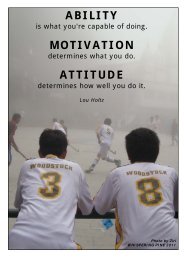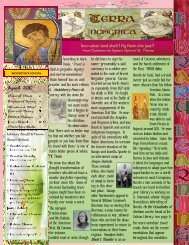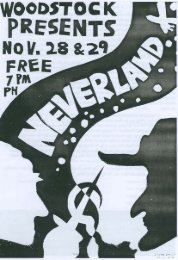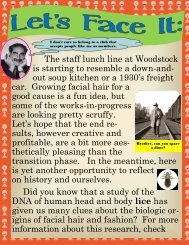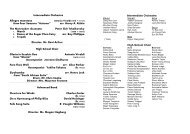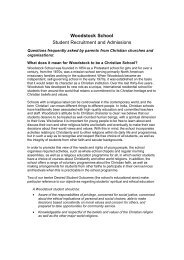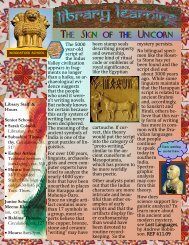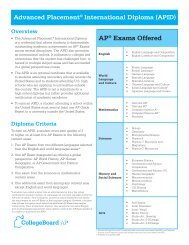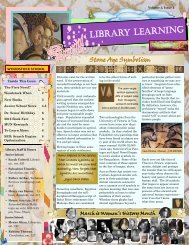McMuse: - Woodstock School
McMuse: - Woodstock School
McMuse: - Woodstock School
Create successful ePaper yourself
Turn your PDF publications into a flip-book with our unique Google optimized e-Paper software.
<strong>McMuse</strong>:<br />
food in the arts<br />
When Andy Warhol started painting Campbell's soup<br />
cans in 1962, the company sent lawyers along to investigate. Little<br />
did they know, then, what an effect the paintings would have on their<br />
sales, as a new movement in art, Pop Art, was born; and all the experts<br />
could do was watch with bemusement and astonishment, as Andy signed<br />
soup cans and sold them as souvenirs.<br />
For the early paintings Andy used the red and white of the original cans -<br />
but later he incorporated a wide variety of arbitrary colours.<br />
In July 1992, Irving Blum's Ferus Gallery in Los Angeles showed a series<br />
of the Soup Can paintings together for the first time, an exhibition that<br />
was to herald the arrival of Pop Art to the west coast. Until that time a few<br />
of the paintings had been scattered around various New York galleries -<br />
but there had been no formal exhibition in New York. This followed later<br />
that year at the Stable Gallery.<br />
In 1997, the Campbell Soup Company, who had by now acknowledged<br />
the importance of the paintings, sponsored the 'Art of Soup' contest,<br />
which marked the 100th birthday of Campbell's soup and the 35th anniversary<br />
of Warhol's homage to it. The winning design was a sheet of commemorative<br />
postage stamps, each one depicting a different flavour of<br />
Campbell's soup submitted by New Jersey man, Dino Sistilli. He was presented<br />
with a cheque for $10,000 at the Andy Warhol Museum in Pittsburgh.<br />
Andy Warhol began as a commercial illustrator, and a very successful<br />
one, doing jobs like shoe ads for I. Miller in a stylish blotty line<br />
that derived from Ben Shahn. He first exhibited in an art gallery in 1962,<br />
when the Ferus Gallery in Los Angeles showed his 32 Campbell's Soup<br />
Cans, 1961-62. From then on, most of Warhol's best work was done over<br />
a span of about six years, finishing in 1968, when he was shot. And it all
flowed from one central insight: that in a culture glutted with information,<br />
where most people experience most things at second or third hand<br />
through TV and print, through images that become banal and disassociated<br />
by repeated again and again and again, there is role<br />
for affectless art.<br />
You no longer need to be hot and full of feeling. You can be supercool,<br />
like a slightly frosted mirror. Not that Warhol worked this<br />
out; he didn't have to. He felt it and embodied it. He was a conduit<br />
for a sort of collective American state of mind in which celebrity -<br />
the famous image of a person, the famous brand name - had<br />
completely replaced both sacredness and solidity. Earlier artists,<br />
like Monet, had painted the same motif in series in order to display<br />
minute discriminations of perception, the shift of light and color<br />
form hour to hour on a haystack, and how these could be recorded<br />
by the subtlety of eye and hand.<br />
From American Visions, by Robert Hughes<br />
Various people have taken credit for suggesting to Andy Warhol<br />
that he paint soup cans, according to Gary Comenas at warholstars.org.<br />
The least believable is Ultra Violet's account. Ultra<br />
says that she ran into the yet to be famous Warhol in 1961 at a<br />
luncheonette on 88th and Madison where he was sitting at the<br />
counter eating chicken soup. When she asked him what he did,<br />
he said he painted. She asked him what he painted and Warhol<br />
supposedly responded, "Not much. I'm looking for ideas."<br />
Pointing to the Campbell soup cans on a shelf, she supposedly<br />
said: "Why don't you paint a soup can," to which Andy responded,<br />
"hmm...."<br />
The problem with Ultra Violet's "personal" recollections is that
they often seem be based on other people's published<br />
accounts of the era. Warhol did not spend<br />
much time with Ultra and she was never really a<br />
part of the druggy culture of the Factory regulars<br />
as she did not take drugs, herself.<br />
According to Ted Carey (who was one of Andy<br />
Warhol's commercial art assistants from approximately<br />
1957 through the early 1960s), it was<br />
Muriel Latow who suggested the idea for both the<br />
soup cans and Warhol's early dollar paintings.<br />
Muriel was an interior decorator with higher aspirations who had<br />
an art gallery (the Latow Gallery) in the East 60s. She told Warhol<br />
he should paint "Something you see every day and something<br />
that everybody would recognize. Something like a can<br />
of Campbell's Soup." Ted Carey, who was there at the time,<br />
said that Warhol responded, "Oh that sounds fabulous." According<br />
to Carey, Warhol went out to the supermarket the following<br />
day and bought a case of "all the soups", which Carey saw<br />
when he stopped by Warhol's apartment the next day.<br />
Another assistant, Vito Giallo, who worked for Warhol in 1958/59,<br />
remembers that Warhol always had soup for lunch - "tomato<br />
soup was his favourite" - which Warhol would eat "watching<br />
TV at the same time... His [Warhol's] mother was there to<br />
make soup and a sandwich. Lettuce, tomato sandwiches,<br />
very simple."



